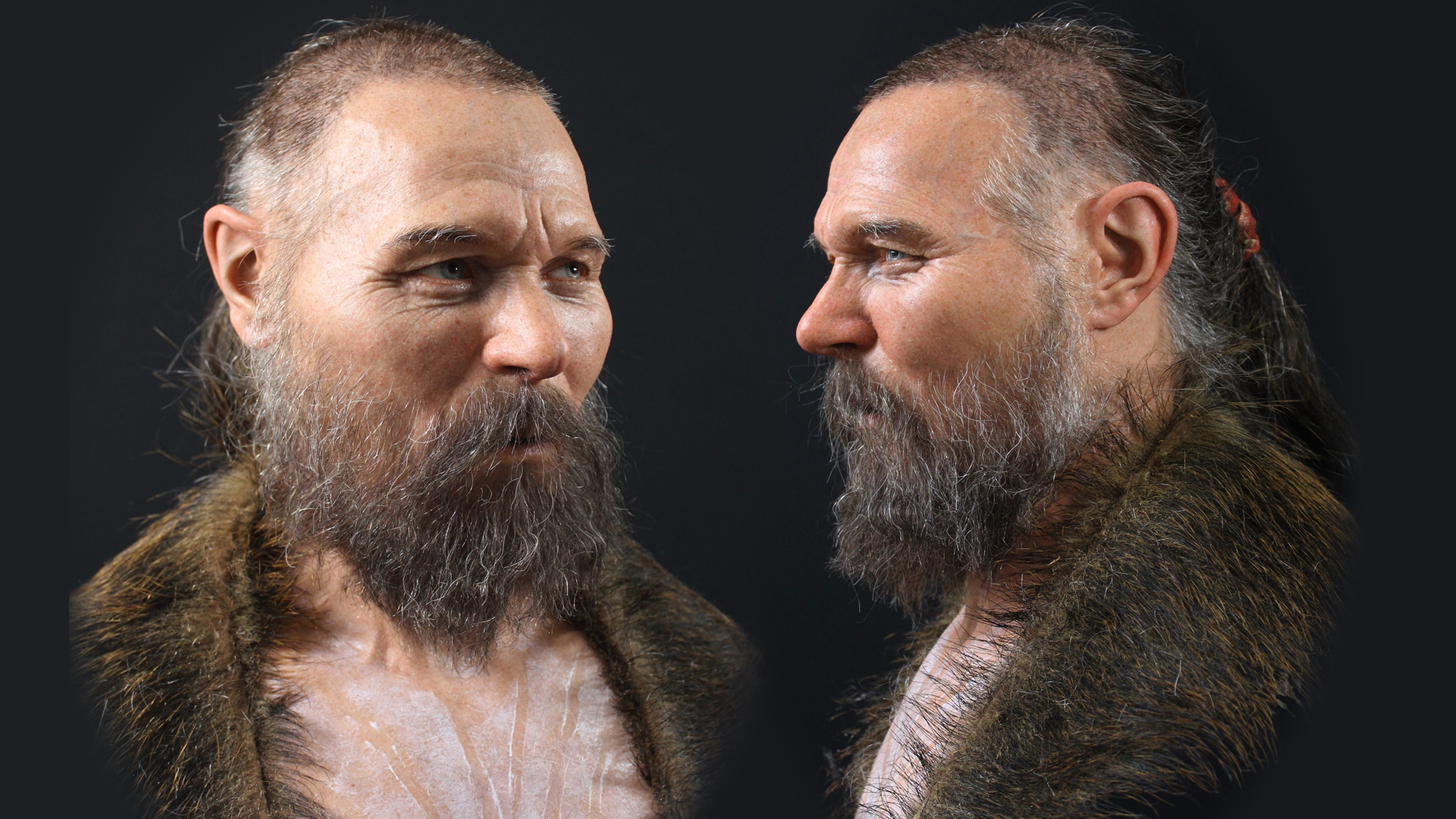This Stone Age man's jawless skull was found on a spike. Here's what he looked like.

We may never know why the skull of a Stone Age man ended up on a stake in a mysterious underwater grave 8,000 years ago, but thanks to a new facial reconstruction, we can see what he probably looked like before he died.
Archaeologists discovered the man's skull, as well as the remains of at least 10 other Stone Age adults and an infant, in 2012 at the bottom of what used to be a small lake in what is now Motala, a municipality in eastern-central Sweden. However, only one of the adults had a jaw; the rest were jawless, and two of the skulls had been placed on stakes sticking out from the lake's surface.
Now, a 3D facial reconstruction reveals the likeness of one of those jawless skulls. Oscar Nilsson, a forensic artist based in Sweden, used this skull as well as genetic and anatomical information gleaned from it to create a bust of the man — a blue-eyed, brown-haired and pale-skinned individual in his 50s.
Related: Stone Age man, whose skull was found on a spike, gets facial recreation (photos)
Nilsson didn't want to damage the ancient skull, so he took a CT (computed tomography) scan of the specimen and used that data to print a 3D replica of it in vinyl plastic. From there, Nilsson determined how thick to make the man's facial muscles and skin based on forensic methods that focus on factors such as the man's weight, height and ethnicity. For instance, this man was from a group of hunters and gatherers whose genetic heritage included people who came to Scandinavia from the north and east, as well as from the south about 2,000 years earlier, Nilsson said.
"However, in this case, there was no jaw," Nilsson told Live Science in an email. "So, the first thing to reconstruct was his jaw," which he did by taking skull measurements.

Almost all the adults in the grave had no jawbones. But the Middle Stone Age, or Mesolithic, grave contained the jawbones of wild animals, including those of brown bears, wild boars, red deer, moose and roe deer, according to a 2018 study on the site, published in the journal Antiquity.
Get the world’s most fascinating discoveries delivered straight to your inbox.
This detail inspired Nilsson's choices for the man's wardrobe and haircut.
"He wears the skin from a wild boar," Nilsson said. "We can see from how the human skulls and animal jaws were found that they clearly meant a big deal in their cultural and religious beliefs."
Moreover, the man has short hair in the reconstruction — "his hairdresser in his time must have used a sharp flint tool for this," Nilsson said — and the man has "a wisp of hair at the back of his head, like a pig's tail."
This short hairstyle lets viewers see a vicious wound — a 1-inch-long (2.5 centimeters) injury on the top of the man's head.
This head wound, however, didn't kill the man — at least not right away. His head injury, as well as the head wounds found on the other individuals in the water burial, showed signs of healing, archaeologists found. In fact, Nilsson added scar tissue on the wound, said study co-lead researcher Fredrik Hallgren, an archaeologist at the Cultural Heritage Foundation in Västerås, Sweden.
"Somebody gave them love and care after this [trauma] and healed them back to life again," Hallgren told Live Science when the 2018 study on the burial first came out.
Related: Stone Age skulls found on wooden stakes (photos)
Meanwhile, the white chalk decorating the man's chest is a piece of artistic license, based on the fact that many Indigenous groups today use chalk for body paint, Nilsson said. "It's a reminder we cannot understand their aesthetic taste, just observe it," he said. "We have no reason to believe these people were less interested in their looks, and to express their individuality, than we are today."
Like many of Nilsson's other creations, including an ancient Wari queen whose remains were found in Peru and an 18-year-old Stone Age woman from Greece, this Mesolithic man looks pensive.
"He is clearly observing something, like a guard or a hunter," Nilsson said. "Can he see us? If so, he would be just as surprised as we are. Almost 8,000 years separates us, genetically we are so alike, but we must accept there are huge differences in how we look at the world."
The bust is now on display at Charlottenborg manor house in Motala, Sweden.
- Photos: See the ancient faces of a man-bun wearing bloke and a Neanderthal woman
- Photos: The reconstruction of a teen who lived 9,000 years ago
- In photos: A nearly complete human ancestor skull
Originally published on Live Science.
OFFER: Save 45% on 'How It Works' 'All About Space' and 'All About History'!
For a limited time, you can take out a digital subscription to any of our best-selling science magazines for just $2.38 per month, or 45% off the standard price for the first three months.

Laura is the archaeology and Life's Little Mysteries editor at Live Science. She also reports on general science, including paleontology. Her work has appeared in The New York Times, Scholastic, Popular Science and Spectrum, a site on autism research. She has won multiple awards from the Society of Professional Journalists and the Washington Newspaper Publishers Association for her reporting at a weekly newspaper near Seattle. Laura holds a bachelor's degree in English literature and psychology from Washington University in St. Louis and a master's degree in science writing from NYU.

